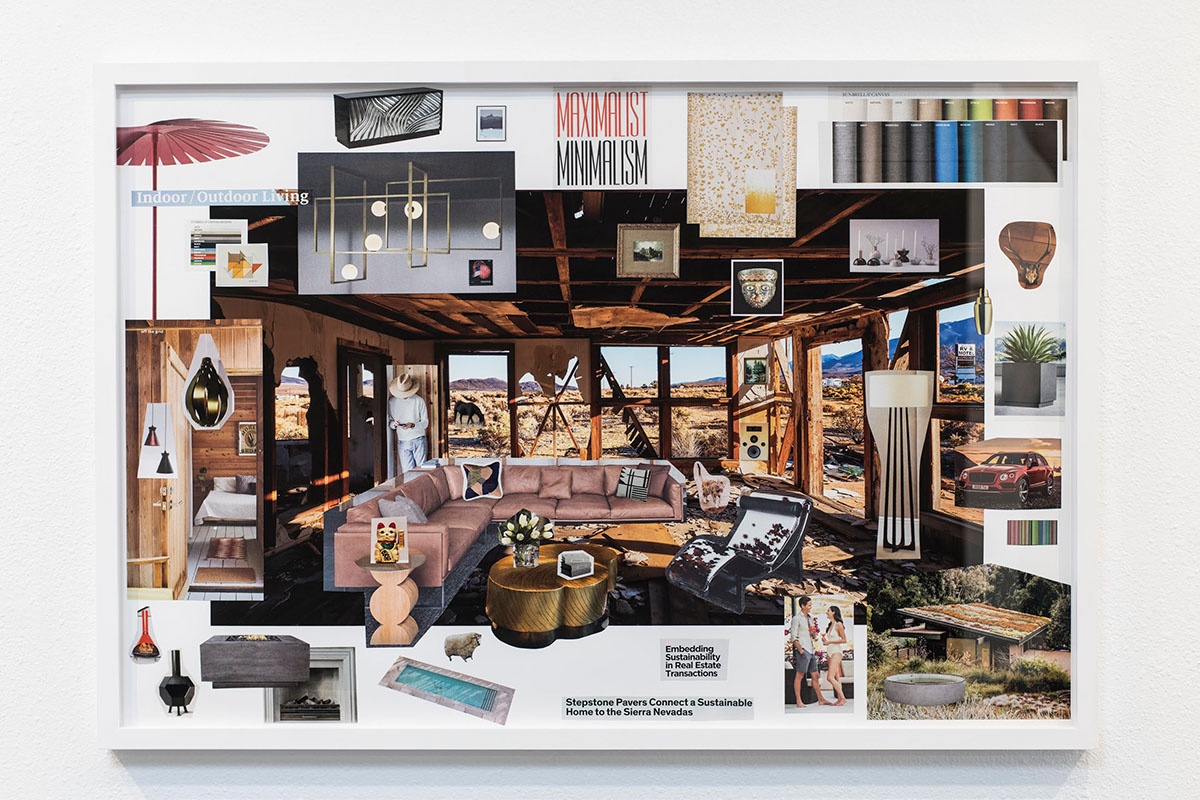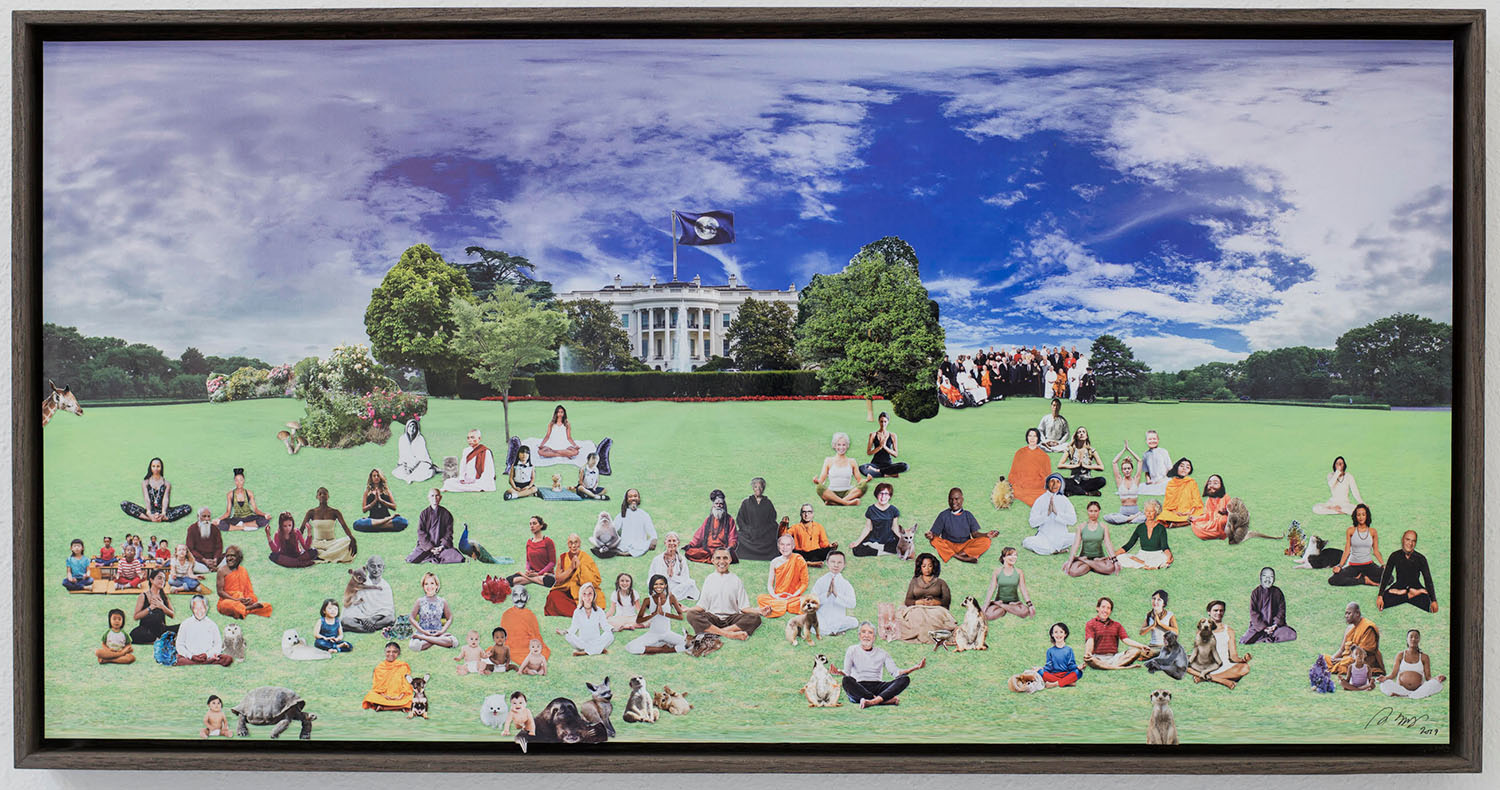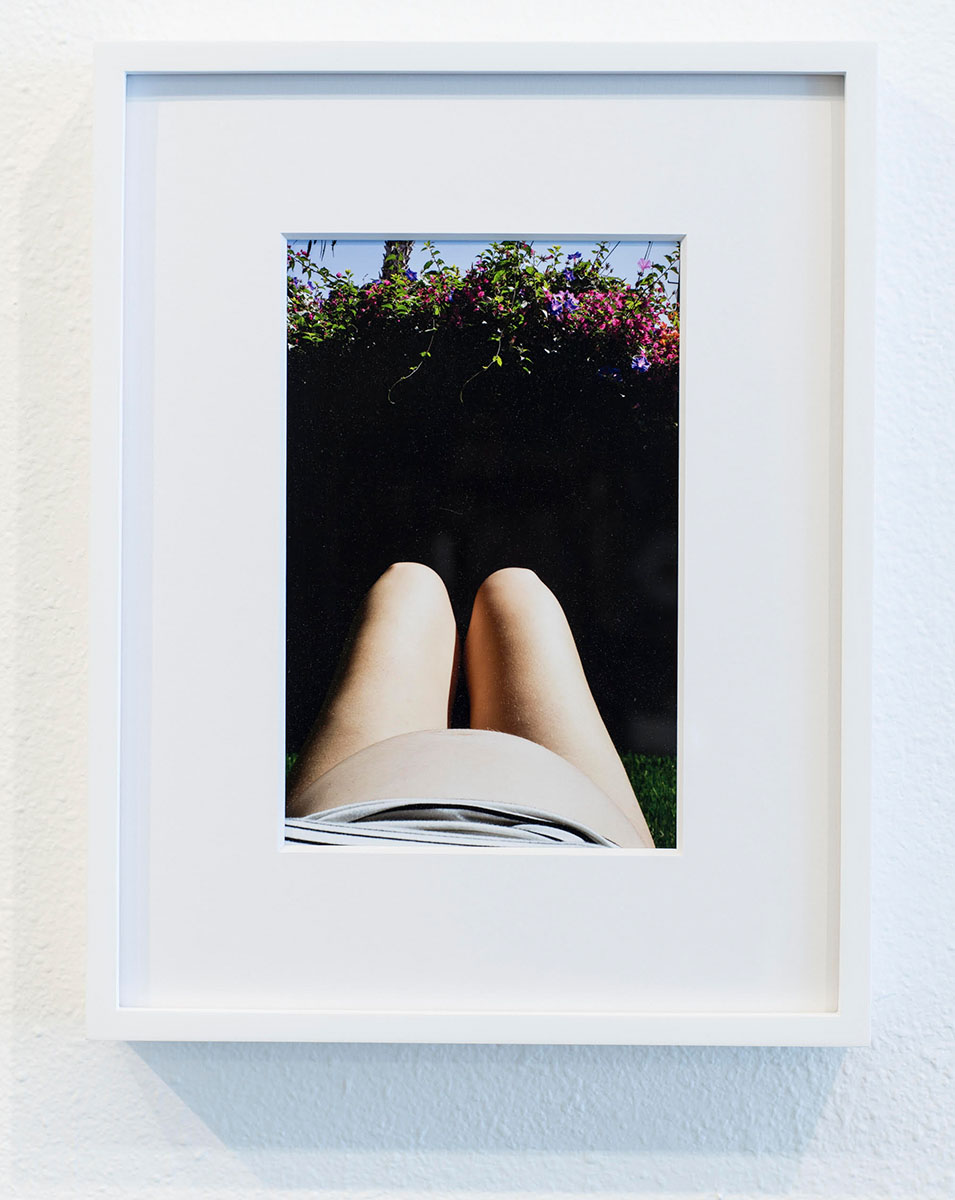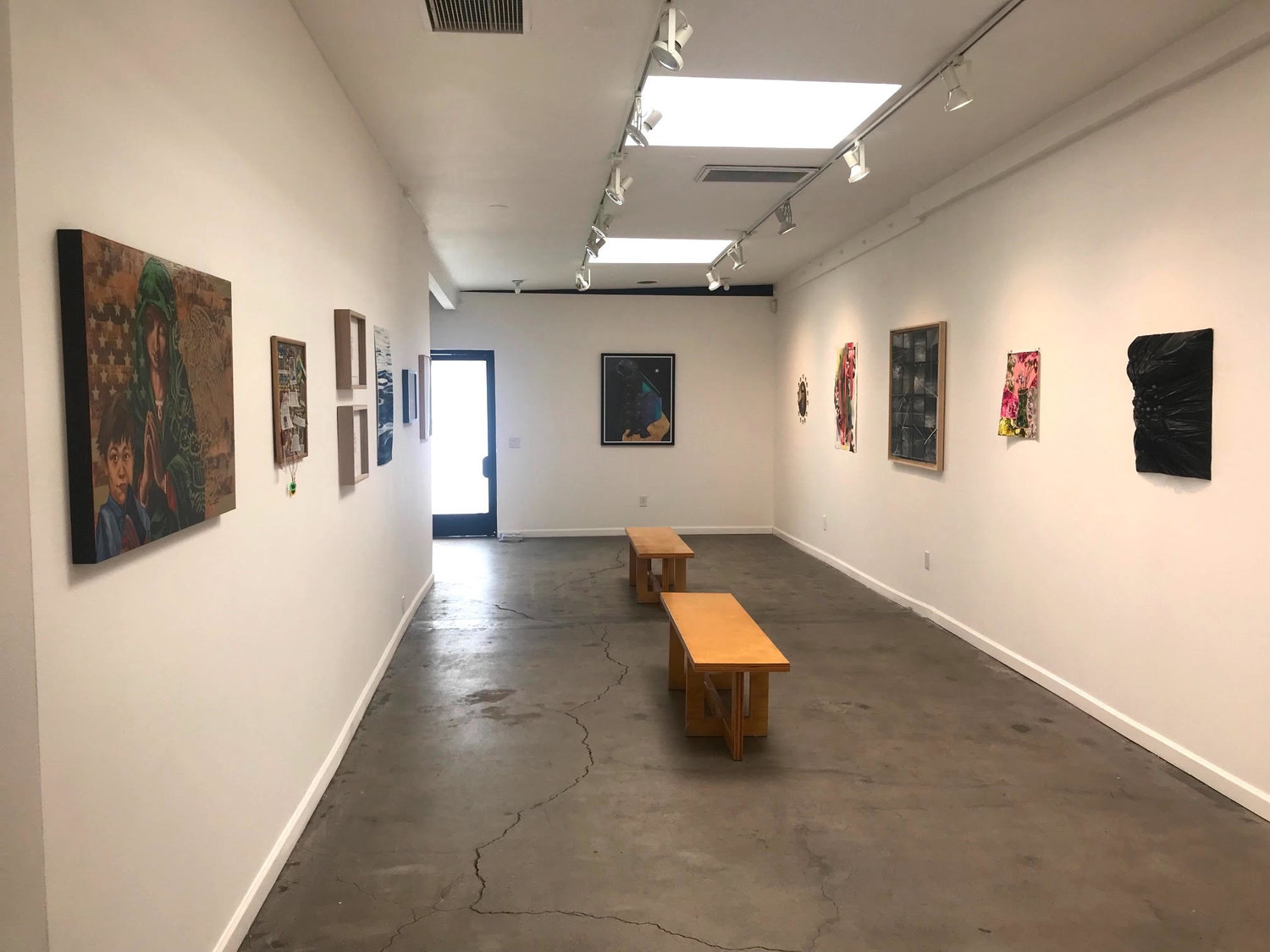The Vision Board, currently on view at Los Angeles’ Kopeikin Gallery, uses photography, painting and other media to elevate “vision board” beyond the kitschy kind of thing you make for your soon-to-be-disregarded New Year’s Resolution. Curated by participating artist Elizabeth Valdez, the show is a powerful display of the necessity of the creative mind, and its unique, unfettered capabilities when it comes to envisioning the future.
Osceola Refetoff’s
The Dream of Sustainability uses the literal mechanism of the “vision board” to communicate a more nuanced message about the future. At first glance, it appears to be a straightforward show interior, with each furnishing and decorative element taken from a different magazine – the kind you make when you’re planning your dream home and feel like shopping in its glossy pages. The proportions and angles of the room and the various couches, tables, and other furnishings are remarkably accurate, to the extent that you wouldn’t know at first glance that the work is a collage rather than a curated spread.
 |
| The Dream of Sustainability © Osceola Refetoff |
Indeed, the room itself is merely the wooden frame of a room, with the landscape visible in chunks through the open walls in the background. A man in a cowboy hat leans against a patch of wall, looking down at his phone, while isolated pictures of wood stoves and fancy hanging lights dot the periphery of the spread. Interior decorating taglines, lifestyle buzzwords, and marketing slogans scatter throughout the composition: “maximalist minimalism” floats at the top of the image; “embedding sustainability in real estate transactions” appears at the bottom.
This piece can be read as a humorous implication of how consumerism co-opts the language of sustainable living and even of reduction, even when reduction is antithetical to the urge to buy more and more stuff. Even living “off the grid,” as we see in a snippet of a woodsy, cleanly-designed bedroom at the far left of the composition, is made sexy. It illustrates the dangers inherent in how we talk about sustainable living in a consumer society: it must be made desirable and appealing to entice consumers into adopting a less wasteful lifestyle, but focusing on the aesthetics and accessories of sustainability merely makes the gesture one of acquiring the right, trendy items--not a sustainable lifestyle at all, but merely a fashion statement. It rewards close looking to appreciate all of the inherent contradictions of this Goop-y, Pinterest-y nightmare.
 |
| The Maharishi Effect, 2019 © Bettina Hubby |
Another photo-collaged work, Bettina Hubby’s
The Maharishi Effect, uses a similarly ironic tone to envision a future straight out of the “I’d Like to Teach the World to Sing” Coca Cola commercial, with a healthy dash of Edward Hicks’
Peaceable Kingdom iconography thrown in there for good measure. Hubby has combined the heads of various famous figures with cut-outs of assorted meditative poses, mingling these hybrid forms with cut-outs of small children and animals on the wide expanse of the White House lawn. Barack Obama’s head is attached to a seated figure near the center, while Michelle, seated beside him, smiles atop a body with her hands pressed together in front of her chest.
Just over to the right we see Oprah meditating next to a large meerkat; Martin Luther King, Jr., Nelson Mandela, and Mother Theresa all make appearances. The flag flying above the White House isn’t the American flag, but rather, contains an image of a moon, shifting the vibe of
The Maharishi Effect from aspirational to downright fantastical: of course, we, too, would like to live in a world where Obama and Dr. King could sit and relax on the White House lawn, surrounded by sloths and meerkats and puppies and babies.
 |
| One World So Many Ways it Could End, 32019 © Erica Rothenberg |
Erica Rothenberg’s
One World, So Many Ways It Could End underplays the drama of its title by presenting the Earth’s various downfalls as slices on a Wheel of Fortune-style device. You’re invited to spin the wheel, into joining your own potential lingering stress with the artist’s. Yet One World, So Many Ways It Could End achieves a remarkable balancing act in its evoking of very real apocalyptic concerns: by placing endings straight out of science fiction films (“evil worms from outer space,” the zombie apocalypse) and religious prophecy (the Rapture) alongside the very real threats of global warming and pandemic illnesses. By staging the entire work as a form of entertainment, Rothenberg critiques the idea of politics and the 24-hour news cycle as spectacle--a spectacle which allows us to ignore the dangers that lie ahead in favor of scoring points in a never-ending horserace game of one-upsmanship.
 |
|
| New York Times, Tuesday September 8, 2020, 2019 Watercolor on paper. © Guy Richard Smit |
While several of the works in
The Vision Board do approach the prompt with this eye for wry humor and sharp critique, other works skip subtlety and dive straight into pure wish fulfillment, and are almost painful in their relatable earnestness. Guy Richard Smit’s painted
New York Times, Tuesday September 8, 2020 is a painted version of a New York Times front page in which Donald Trump is led from the Oval Office in an orange jumpsuit, ashamed and contrite and powerless. At first glance, Smit’s work is frustrating in its lack of subtlety, because it doesn’t take an artist’s creative eye to envision this future: it’s the subject of a million different poorly-edited Twitter graphics and hashtags.
And yet
New York Times, Tuesday September 8, 2020 seems to acknowledge its own heavy-handedness: a small roughed-out column in the lower corner of the front-page-style image is titled “Timid New Voice in Painting Wows the Art World: Incredibly Subtle and Nuanced.” That self-dig isn’t quite enough to distract from the overall cliched quality of the artist’s “vision board,” but then again, perhaps it’s enough of an indictment of the world in which we live that a simple dream of justice comes across as obvious and clunky. Imagine a world in which our leaders disregarding the rule of law didn’t merit shrug after shrug, but were treated with the gravity they deserve, leading to satisfying conclusions.
.jpg?format=1500w) |
|
| The Secret Language of Dreams from the series BookPace, 2002 (Sorted books project, 1993-ongoing) © Nina Katchadourian |
Other pieces in
The Vision Board take a more intimate approach to a potential future. Nina Katchadourian’s
The Secret Language of Dreams is a simple, serene image of several books stacked on top of one another, one of which bears the title of the overall work. In Katchadourian’s idealized future, one imagines, we have the freedom and time to read books about dreams, or about swimming pools, or whatever we please; we can even read a book about
Queues, Rendezvous, Riots without feeling the urge to participate in a riot. Katie Shapiro’s photograph
Belly Legs conjures up a similar level of individualized peace: a world in which you can lie back, observe your rounded, pregnant belly, and not worry existentially about the future of the being growing inside. Rather than weighing on societal changes at large, Katchadourian and Shapiro extrapolate more personal interpretations of their visions of the future into larger statements about--and potential condemnations of--the imperfect, chaotic world in which we live now.
 |
| Belly Legs, 2019 © Katie Shapiro |
Nancy Buchanan’s searing
Vision Quest(ions) makes a crucial link from the past to the present, perhaps showing the ultimate futility of imagining the future as something entirely and radically different. The work takes the form of a vintage “Wahoo” board game replete with caricatured images of Native Americans, with text on vellum inserts functioning as interventions to address the ongoing history of anti-Native American racism and current state of white supremacy in the United States. Informative passages on the history of Native American mascots and their lingering racist legacies are juxtaposed with Congressman Steve King of Iowa’s infamous quote, where he questions why the terms “white supremacist” and “white nationalists” have become “something offensive.”
Vision Quest(ions) serves as a powerful reminder that the past was at one point the present; the present moment was a thus hazy future just beyond the horizon, when everything would magically improve, where the biases and hatred of the past would no longer hold weight.
+2019.jpg?format=1500w) |
| Vision Quest(ions,) 2019 © Nancy Buchanan |
Arnold Hauser wrote in
The Sociology of Art: “great art gives us an interpretation of life which enables us to cope more successfully with the chaotic state of things and to wring from life a better, that is, a more convincing and more reliable, meaning.”
The Vision Board stands as a testament to the importance of the existence of artists, especially in times of turmoil. Whether it’s helping us to make sense of our present moment, understanding the lingering implications of the past, or conjuring a new future before our eyes, artists continue to have a critical role to play in how we live and take in our world.




.jpg?format=1500w)

+2019.jpg?format=1500w)

Comments
Post a Comment